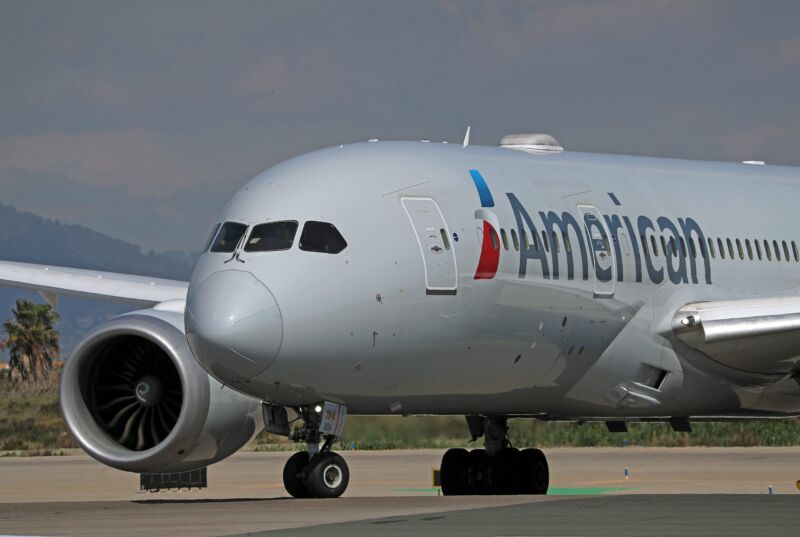
The Federal Aviation Administration is investigating whether Boeing failed to complete required inspections on 787 Dreamliner planes and whether Boeing employees falsified aircraft records, the agency said this week. The investigation was launched after an employee reported the problem to Boeing management, and Boeing informed the FAA.
"The FAA has opened an investigation into Boeing after the company voluntarily informed us in April that it may not have completed required inspections to confirm adequate bonding and grounding where the wings join the fuselage on certain 787 Dreamliner airplanes," the FAA said in a statement provided to Ars today.
The FAA said it "is investigating whether Boeing completed the inspections and whether company employees may have falsified aircraft records. At the same time, Boeing is reinspecting all 787 airplanes still within the production system and must also create a plan to address the in-service fleet." The agency added that it "will take any necessary action—as always—to ensure the safety of the flying public."
Boeing exec confirms skipped tests
Boeing VP Scott Stocker, who leads the 787 Dreamliner program, described "misconduct" in an April 29 email to employees in South Carolina. Boeing provided a copy of the email to Ars.
"After receiving the report, we quickly reviewed the matter and learned that several people had been violating Company policies by not performing a required test, but recording the work as having been completed," Stocker wrote. "As you all know, we have zero tolerance for not following processes designed to ensure quality and safety. We promptly informed our regulator about what we learned and are taking swift and serious corrective action with multiple teammates."
Stocker's email praised a Boeing employee, or "teammate" as he called him, for reporting the problem. "The teammate saw what appeared to be an irregularity in a required conformance test in wing body join," Stocker wrote. "He raised it with his manager, who brought it to the attention of executive leadership. I wanted to personally thank and commend that teammate for doing the right thing. It's critical that every one of us speak up when we see something that may not look right, or that needs attention."
Stocker wrote that Boeing's "engineering team has assessed that this misconduct did not create an immediate safety of flight issue." But there will be an impact on customers and employees "because the test now needs to be conducted out of sequence on airplanes in the build process." Stocker urged employees "to ensure full compliance with our policies and procedures" and to "speak up if you see something that doesn't seem right."
Dreamliner cockpit problem
In March, about 50 people were injured on a LATAM Airlines flight in which a Boeing 787-9 Dreamliner experienced a "strong shake" that reportedly caused some passengers' heads to hit the ceiling. Boeing subsequently "advised airlines to check the cockpit seats on 787 Dreamliner jets after a seat mishap likely pushed a pilot into the controls," The Wall Street Journal wrote.
The WSJ wrote that in the LATAM incident, a "flight attendant hit a switch on the pilot's seat while serving a meal, leading a motorized feature to push the pilot into the controls and push down the plane's nose, according to US industry officials briefed on preliminary evidence from an investigation. The switch, on the back of the chair, is usually covered and isn't supposed to be used when a pilot is in the seat."
Boeing sent a memo to airlines "recommending that they inspect the cockpit chairs for loose covers on the switches and instructing them how to turn off power to the pilot seat motor if needed," the WSJ wrote.
Boeing scrutiny
Boeing has been under increased scrutiny since January when a 737 Max 9 used by Alaska Airlines was forced to make an emergency landing because a door plug blew off the aircraft in mid-flight. The National Transportation Safety Board found that four bolts that were supposed to secure the door plug were missing.
The NTSB also told US senators that its door-plug investigation was hampered by a lack of repair records and security camera footage. Boeing was unable to find records documenting work on the door plug and said it only kept video recordings for 30 days before they are overwritten.
Boeing also withdrew an application for a safety exemption related to its 737 Max 7 aircraft after criticism from US Sen. Tammy Duckworth (D-Ill.). Duckworth criticized Boeing for seeking "an exemption from safety standards to prematurely allow the 737 Max 7 to enter commercial service."
Recent news reports describe the deaths of two whistleblowers, one who worked for Boeing and another who worked for a Boeing supplier. Former Boeing quality manager John Barnett died in March from what a coroner said "appears to be a self-inflicted gunshot wound." Barnett worked at Boeing for 32 years and "became a whistleblower at the South Carolina factory that builds the 787 Dreamliner" before resigning in 2017, CBS News wrote.
The second whistleblower death occurred a week ago. "Joshua Dean, a former quality auditor at Boeing supplier Spirit AeroSystems and one of the first whistleblowers to allege Spirit leadership had ignored manufacturing defects on the 737 Max, died Tuesday morning after a struggle with a sudden, fast-spreading infection," The Seattle Times wrote last week.
reader comments
223